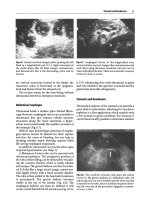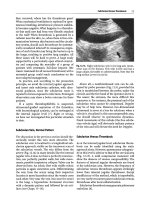CATHETER-RELATED INFECTIONS IN THE CRITICALLY ILL - PART 1 doc
Bạn đang xem bản rút gọn của tài liệu. Xem và tải ngay bản đầy đủ của tài liệu tại đây (722.16 KB, 19 trang )
CATHETER-RELATED INFECTIONS
IN THE CRITICALLY ILL
CATHETER-RELATED INFECTIONS
IN THE CRITICALLY ILL
Naomi P. O’Grady, M.D.
Critical Care Medicine Department
Warren Grant Magnuson Clinical Center
National Institutes of Health
10 Center Drive
Building 10, Room 7D43
Bethesda, MD 20892
and
Didier Pittet, M.D.
University Hospital
Infection Control Program
Department of Internal Medicine
University of Geneva Hospitals
1211 Geneva 14
Switzerland
Edited by
KLUWER ACADEMIC PUBLISHERS
NEW YORK, BOSTON, DORDRECHT, LONDON, MOSCOW
eBook ISBN: 1-4020-8010-7
Print ISBN: 1-4020-8009-3
Print ©2004 Kluwer Academic Publishers
All rights reserved
No part of this eBook may be reproduced or transmitted in any form or by any means, electronic,
mechanical, recording, or otherwise, without written consent from the Publisher
Created in the United States of America
Boston
©2004 Springer Science + Business Media, Inc.
Visit Springer's eBookstore at:
and the Springer Global Website Online at:
CONTENTS
v
Contributors
Preface
Naomi P. O’Grady and Didier Pittet
Perspectives on Critical Care Infectious Disease: An
Introduction to the Series
Jordi Rello, M.D.
1.
2.
3.
4.
5.
The Epidemiology of Catheter-Related
Infection in the Critically Ill
Nasia Safdar, M.D., Leonard A. Mermel, D.O., Sc.M.
Dennis G. Maki, M.D.
Epidemiology and Pathogenesis of Catheter-Related
Bloodstream Infections
Antonio Sitges-Serra, F.R.C.S. (Ed.)
Diagnosis
Stephen O. Heard, M.D., F.C.C.M.
Diagnosis of Catheter-Related Infections
Gérard Nitenberg, M.D., François Blot, M.D.
The Impact of Catheter-Related Infection in
the Critically Ill
Christian Brun-Buisson, M.D.
The Impact of Catheter-Related Bloodstream
Infections
Karin E. Byers, M.D., M.S., Barry M. Farr, M.D., M.Sc.
Management and Treatment
Amar Safdar, M.D. and Issam I. Raad, M.D.
vii
xi
xiii
1
23
41
59
77
6.
7.
87
99
The Management and Treatment of Intravascular
Catheter-Related Infections
Professor T.S.J. Elliott
Education as the Primary Tool for Prevention
Phillippe Eggimann, M.D., Didier Pittet, M.D., M.S.
Education as an Intervention for Reducing
Vascular Catheter Infections
Robert J. Sherertz, M.D.
ICU Prevention Strategies
Jean-François Timsit, M.D.
Novel Strategies of Preventing Catheter-Related
Infections in the ICU
Naomi P. O’Grady, M.D.
Catheter-Related Infections in the Critically Ill
vi
9.
10.
11.
12.
8.
113
127
139
147
159
173
Index
vii
François Blot, M.D.
Service de Réanimation Polyvalente
Institut Gustave Roussy
Villejuif, France
Christian Brun-Buisson, M.D.
Department of Intensive Care and Infection Control Unit
Centre Hospitalier Universitaire Henri Mondor
Assistance Publique Hôpitaux do Paris and Université Paris
Paris, France
Karin E. Byers, M.D., M.S.
University of Pittsburgh Medical Center
Pittsburgh, PA
Phillippe Eggimann, M.D
Medical Intensive Care Unit and Infection Control Program
Department of Internal Medicine
University of Geneva Hospitals
Geneva, Switzerland
Prof. T.S.J. Elliott
Department of Clinical Microbiology
University Hospital Birmingham NHS Trust
The Queen Elizabeth Hospital, Edgbaston
Birmingham, United Kingdom
Barry M. Farr, M.D., M.Sc.
University of Virginia Health System
Charlottsville, Virginia
Stephen O. Heard, M.D., F.C.C.M.
Department of Anesthesiology
University of Massachussetts Medical Center
Worcester, Massachusetts
CONTRIBUTORS
viii
Dennis G. Maki, M.D.
Section of Infectious Diseases
Department of Medicine
University of Wisconsin Medical School
Madison, Wisconsin
Leonard A. Mermel, D.O., Sc.M.
Division of Infectious Disease
The Rhode Island Hospital, Brown Medical School
Providence, Rhode Island
Gérard Nitenberg, M.D.
Service de Réanimation Polyvalente
Institut Gustave Roussy
Villejuif, France
Naomi P. O’Grady, M.D.
Warren Magnusen Clinical Center
Critical Care Medicine Department
National Institutes of Health
Bethesda, Maryland
Didier Pittet, M.D., M.S.
Medical Intensive Care Unit and Infection Control Program
Department of Internal Medicine
University of Geneva Hospitals
Geneva, Switzerland
Issam I. Raad, M.D.
The University of Texas
M.D. Anderson Cancer Center
Houston, Texas
Amar Safdar, M.D.
The University of Texas
M.D. Anderson Cancer Center
Houston, Texas
ix
Nasia Safdar, M.D.,
Section of Infectious Diseases
Department of Medicine
University of Wisconsin Medical School
Madison, Wisconsin
Robert J. Sherertz, M.D.
Division of Infectious Diseases
Wake Forest University School of Medicine
Winston Salem
North Carolina
Antonio Sitges-Serra, F.R.C.S (Ed.)
Department of Surgery
Hospital Universitari del Mar
Barcelona, Spain
Jean-François Timsit, Ph D.
Réanimation Médicale et Infectieuse
Hôpital Bichat-Claude Bernard
Paris, France
This page intentionally left blank
Preface
Intravascular catheters are an integral part of the daily practice of
medicine in the intensive care unit. As such, management of these catheters
poses significant challenges to the practitioner. Vascular access is necessary
in the intensive care setting, yet the devices themselves put patients at
significant risk for infection. As hospital infection rates are increasingly used
as a surrogate marker for measuring patient safety and quality healthcare,
preventing catheter-related infection takes on added importance.
It is the intent of this issue to provide the intensivist with a collection of
reviews that detail a practical approach to the prevention and management of
catheter-related infections and to highlight some of the recent advances in
novel technologies and strategies to prevent infection. As patients require
catheters for longer periods of time, the types of catheters that are being
placed are changing. Although tunneled catheters are still frequently placed
in patients who are known to require extended vascular access, peripherally
inserted central catheters are rapidly becoming a reasonable alternative, both
in the outpatient and the intensive care setting. When temporary central
venous catheters are placed, often antibiotic or antiseptic-coated devices are
used. Although they are more expensive to purchase, data supports an overall
decrease in hospital cost when the price of extra hospital days for infection is
factored into the equation. Last but not least, in some institutions, strategies
based on educational interventions of critical care staff proved to be
extremely efficacious at reducing infection rates and at least as cost-effective
as the use of antimicrobial-coated devices, and with no fear about resistance
acquisition.
Given the changing types of catheters placed today, the epidemiology and
pathogenesis of infection has also changed over the past ten years. Data
regarding biofilms and the role they play in catheter infections take on added
significance when coupled with the extended dwell times of catheters.
Finally, managing catheter infections in the intensive care unit has become
increasingly challenging. Often it is not so simple to take out one catheter
and replace it with a new one. Patients often have limited access,
coagulopathies, or other anatomical and clinical considerations that preclude
removing the central catheter. There are data to support leaving a catheter in
place and treating through an infection in certain situations.
We hope that this volume will provide the reader with insights into some
of the most interesting and useful data in the field of catheter-related
infection. We hope too that the strategies highlighted to prevent infection
will be implemented and will have a measurable impact in decreasing rates
of infection in the intensive care unit setting. We are very grateful to each of
the contributors for the time and effort they have expended to make this a
useful and exciting reference tool. We also appreciate Dr. Jordi Rello for the
opportunity to prepare this volume in the Perspectives Series. Lastly, we
would not have been able to complete this task without the exceptional
editorial assistance from Ms. Jennifer Candotti, to whom we are most
appreciative.
xii
Catheter-Related Infections in the Critically Ill
Naomi P. O’Grady, M.D.
Didier Pittet, M.D., M.S.
Guest Editors
PERSPECTIVE
S
ON CRITICAL CARE INFECTIOUS DISEASES
Different models of intensive care medicine have been developed worldwide,
involving surgeons, anesthetists, internists and critical care physicians. All
intensive care departments of hospitals have in common, the highest incidence
of antibiotic consumption, the highest incidence of nosocomial infections and
are grouping community-acquired infections with high degrees of severity.
Intensive care areas of hospitals have the largest number of infection
outbreaks and require differentiated strategies of prevention.
The specific characteristics of the involved population require differentiated
approaches in diagnosis and therapy from those required in classical
infectious problems. The specific pharmacodynamic conditions of patients
requiring mechanical ventilation or continuous renal replacement, require
participation of experts in pharmacology.
The specific objective of this Series is to update therapeutic implications and
discuss controversial topics in specific infectious problems involving
critically ill patients. Each topic will be discussed by two authors
representing the different management perspectives for these controversial
and evolving topics. The Guest Editors, one from North America and one
from Europe, have invited contributors to present the most recent findings and
the specific infectious disease problems and management techniques for
critically ill patients, from their perspective.
An Introduction to the Series
Jordi Rello, M.D.
Series Editor
This page intentionally left blank
Chapter 1
TH
E
EPIDEMIOLOGY OF CATHETER-
RELATED INFECTION IN THE CRITICALLY
ILL
Nasia Safdar, M.D., Leonard A. Mermel, D.O., Sc.M.,
Dennis G. Maki, M.D.
Section of Infectious Diseases (NS, DGM), Department of Medicine, University of Wisconsin
Medical
School, Madison, Wisconsin, and the Division of Infectious Disease (LAM), the
Rhode Island Hospital, Brown Medical School, Providence, Rhode Island
Introduction
Vascular access is one of the most essential features of modern critical
care medicine. In the Intensive Care Unit (ICU), the entire range of
intravascular devices (IVDs) needed for vascular access is encountered:
central venous catheters of every type, including noncuffed multilumen
catheters, large dual-lumen catheters for hemodialysis, large introducers and
flow-directed, balloon-tipped pulmonary artery (Swan-Ganz) catheters,
cuffed and tunneled Hickman-like CVCs, arterial catheters used for
hemodynamic monitoring, small peripheral venous catheters and,
increasingly peripherally-inserted central venous catheters (PICCs).
Unfortunately, the IVDs needed to establish reliable access are associated
with significant potential for producing iatrogenic disease, particularly
bacteremia and candidemia (1-3), deriving from infection of the
2
Catheter-Related Infections in the Critically Ill
percutaneous device used for vascular access or from contamination of the
infusate administered through the device (4).
The forms of infection associated with IVDs range from exit site
infection purulence, inflammation and erythema at the site; local infection,
usually asymptomatic, synonymous with colonization of the catheter;
bloodstream infection (BSI) , the most serious, potentially fatal complication
of IVDs and the gravest infectious complication of vascular access, septic
thrombophlebitis of peripheral veins and septic thrombosis of the great
central veins (Table 1) (5).
MAGNITUDE OF THE PROBLEM
More than 250,000 IVD-related BSIs occur in the United States each year
(1); the majority are related to short-term noncuffed, percutaneously-placed
central venous catheters (CVCs). Whereas earlier studies have found a 12-
25% attributable mortality of IVD-related BSI (6-9), recent studies have
questioned the attributable mortality of IVD-related BSIs and primary BSI;
10-1
3
however, these infections are associated with prolongation of hospital
stay (7-9, 14) and marginal cost to the health system of $33,000 to 35,000
per episode (7, 8, 14) The risk is greatly amplified in the ICU setting where
at least 80,000 IVDR BSIs occur annually (3,15) with a marginal cost of
$33,000 to $71,000 per case (15).
Th
e
magnitude of risk of IVD-related BSI varies with the type of IVD in
place (Table 2) (16). The device that poses the greatest risk of IVDR BSI
today is the CVC in its many forms: short-term noncuffed, single- or multi-
lumen catheters inserted percutaneously into the subclavian, internal jugular
or femoral vein have been associated with rates of catheter-related BSI in the
range of 3 to 5% (2- 3 per 1000 IVD-days). Far lower rates of infection occur
with surgically implanted cuffed Hickman or Broviac and subcutaneous
central venous ports (1 and 0.2 per 1000 IVD-days, respectively). Contrary
to popular belief, PICCs used in a hospitalized population, and arterial
catheters are associated with a risk of catheter-related BSI approaching that
seen with noncuffed multilumen CVCs; up to 2.1% and 3.7 BSIs per 1000
IVD-days, and 1.5% and 2.9 per 1000 IVD-days, respectively. The increased
risk observed with PICCs in hospitalized patients is especially of importance
as PICC sales in the U.S have risen greatly and are expected to continue to
rise.
Nasia Safdar, Leonard A. Mermel, and Dennis G. Maki
3
Rates of IVDR-BSI are also influenced by severity of illness and
underlying diseases: granulocytopenic patients, HIV, and those undergoing
marrow transplantation have a much higher risk of IVDR BSI. However,
risk can be greatly reduced by good catheter care practices and consistent
applicatio
n
of strategies shown to reduce risk of IVDR-related BSI.
4
Catheter-Related Infections in the Critically Ill
Nasia Safdar, Leonard A. Mermel, and Dennis G. Maki
5









